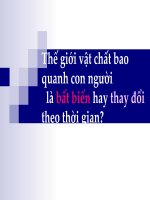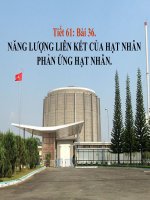BÀI GIẢNG PHIÊN DỊCH
Bạn đang xem bản rút gọn của tài liệu. Xem và tải ngay bản đầy đủ của tài liệu tại đây (3.96 MB, 24 trang )
Interpreting and Translation
SESSION FOUR
INTERPRETING
…which is also Group 2 4332
Table of Contents
I. Definition
Interpreting or Translation
II. Modes of Interpreting
Consecutive Interpreting
Simultaneous
Interpreting
III. Interpreting
Process
Extras
Practice questions
Conclusion/Ending
ToC
I. What is INTERPRETING
Render information
Language
↔ Language
Through means of speaking
Vocabulary
INTERPRETER(n) must INTERPRET(v) for the audience.
INTERPRETER(n) will provide INTERPRETATIONS(n) for the
audience.
INTERPRETING(n) is a process in which the INTERPRETER(n)
transfers real-time spoken source language into target
language.
ToC
Depends on the situation
INTEPRETING or TRANSLATION
Mostly real-time spoken language
Happens on the spot
Live setting
Language 1
→ Accuracy varies
↔ Language 2 ↔ …*
Mostly text-based
Can be done long after the creation of
the source document
Has time to review and edit the
product
Source language
→ Target Language
ToC
II. MODES OF INTERPRETING
CONSECUTIVE INTERPRETING
Speaker talks then
interpreter converts
SIMULTANEOUS INTERPRETING
Interpreter interprets at the
same time as the source
By sentence
Sight Translation
Whole
speech
Whispered interpretation
Unilateral
Bilateral
Liaison
Electronic hook-up
Interpreting map
(that we found on Google)
Back
CONSECUTIVE INTERPRETING
Interpreter gives rendering of a
speech
Structured and accurate
No major changes to
meaning
Interpreters connect the
audience with the speaker
linguistically
No omissions of detail
Back
Unilateral
(one-way)
consecutive interpreting
Speaker → Language A → Interpreter ⇄ Language B
⇄ Audience
Sentence by
sentence
- More instantaneous/on the spot
- More confusing to understand as a whole
By a whole speech
- Lengthier interpreting process
- More understandable and coherent as a
whole
Note: Dashed line = source language; blue line = target language/interpretation
Back
Bilateral
(two-way)
consecutive interpreting
Speaker A ⇄ Language A ⇄ Interpreter ⇄ Language B
⇄ Speaker B
Interpreter is in close contact with
speakers
Indirect interaction between speakers via the
interpreter
Assisting equipment may not need to be
used
(except web conferencing)
Back
The requirements
for an interpreter.
Language proficiency
Good memory
Concentration
Soft skills
Knowledge (culture, etc)
…
(sorry I ran out of ideas)
Back
SIMULTANEOUS INTERPRETING
Interpreter converts source language into target
language(s)
No disruption of the original flow of delivery
Speaker
(Source language)
Interpreter 1
Target language
1
Audience 1
Interpreter 2
Target language
2
Audience 2
Interpreter …
Target language
…
Audience …
Back
Sight translation
Interpreter giving a sight translation
from a book
Back
Whispered interpreting
Interpreter converting questions into French so the athlete
can understand
Back
Electronic hook-up
(computer-assisted)
Interpreters in a specialized booth along with equipment
during a meeting
Back
III. PROCESS OF INTERPRETING
Decipheri
ng
Filter out the concept/idea
Transference
Understandin
Input
g
Transfer concept/idea into target
language
Context &
Culture
Know
the
meaning
Output 1 Idiomatic expression
Outputs
Output 2 Transferred Meaning
Back
Extras
Inspirational image
Practice questions
*insert inspirational quote*
Extra
s
Extra
s
Questions
1
2
3
4
Qs
Question 1:
The speaker talks in Spanish and you need to interpret for English
audience. The speech is 5 minutes long. Choose the best mode
of interpreting.
A. Simultaneous interpreting
B. Unilateral consecutive interpreting
C. Bilateral consecutive interpreting
Qs
Question 2:
You are an interpreter for a foreign author in a talk show. Their
newest book is still in English and you need to interpret the
book’s content for the Vietnamese audience. Choose the best
mode of interpreting.
A. Sight translation
B. Liaison interpreting
C. Bilateral consecutive interpreting
Qs
Question 3:
Match the images with the modes of interpreting.
1
2
A. Liaison interpreting
3
B. Sight translation
C. Whispered interpreting
Qs
Question 4:
2
4
T
3
R
U
A
N
1
N
I
L
S
L
I
L
A
A
A
T
I
S
N
T
E
E
R
P
R
E
R
O
A
N
L
T
1 (.adj) Bilateral interpreting mode.
2 (.v) Same as interpret but text-based.
3 (.adj) One-way
-
4 (.v) ???
-
Back
Presentation is done.









